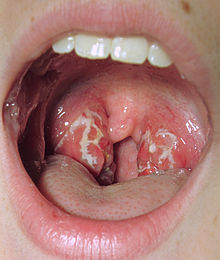| Tonsillitis | |
|---|---|
 | |
| A culture-positive case of streptococcal pharyngitis with typical tonsillar exudate in a 16-year-old | |
| Pronunciation | |
| Specialty | Infectious disease |
| Symptoms | Sore throat, fever, enlargement of the tonsils, trouble swallowing, large lymph nodes around the neck[1][2] |
| Complications | Peritonsillar abscess[1][3] |
| Duration | ~ 1 week[4] |
| Causes | Viral infection, bacterial infection[1][5][6] |
| Diagnostic method | Based on symptoms, throat swab, rapid strep test[1][5] |
| Medication | Paracetamol (acetaminophen), ibuprofen, penicillin[1][5] |
| Frequency | 7.5% (in any given 3 months)[7] |
Tonsillitis is inflammation of the tonsils in the upper part of the throat. It can be acute or chronic.[8][9][2] Acute tonsillitis typically has a rapid onset.[10] Symptoms may include sore throat, fever, enlargement of the tonsils, trouble swallowing, and enlarged lymph nodes around the neck.[1][2] Complications include peritonsillar abscess (quinsy).[1][3]
Tonsillitis is most commonly caused by a viral infection and about 5% to 40% of cases are caused by a bacterial infection.[1][5][6] When caused by the bacterium group A streptococcus, it is classed as streptococcal tonsillitis[11] also referred to as strep throat.[12] Rarely bacteria such as Neisseria gonorrhoeae, Corynebacterium diphtheriae, or Haemophilus influenzae may be the cause.[5] Typically the infection is spread between people through the air.[6] A scoring system, such as the Centor score, may help separate possible causes.[1][5] Confirmation may be by a throat swab or rapid strep test.[1][5]
Treatment efforts involve improving symptoms and decreasing complications.[5] Paracetamol (acetaminophen) and ibuprofen may be used to help with pain.[1][5] If strep throat is present the antibiotic penicillin by mouth is generally recommended.[1][5] In those who are allergic to penicillin, cephalosporins or macrolides may be used.[1][5] In children with frequent episodes of tonsillitis, tonsillectomy modestly decreases the risk of future episodes.[13]
About 7.5% of people have a sore throat in any three-month period and 2% of people visit a doctor for tonsillitis each year.[7] It is most common in school-aged children and typically occurs in the colder months of autumn and winter.[5][6] The majority of people recover with or without medication.[1][5] In 82% of people, symptoms resolve within one week, regardless if bacteria or viruses were present.[4] Antibiotics probably reduce the number of people experiencing sore throat or headache, but the balance between modest symptom reduction and the potential hazards of antimicrobial resistance must be recognised.[4]
- ^ a b c d e f g h i j k l m n "Pharyngitis-Tonsillitis in Children and Adults" (PDF). Institut national d'excellence en santé et en services sociaux (INESSS). March 2016. Retrieved 22 November 2020.
- ^ a b c "Acute Tonsillitis". NCIthesaurus. Retrieved 3 November 2020.
- ^ a b Klug TE, Rusan M, Fuursted K, Ovesen T (August 2016). "Peritonsillar Abscess: Complication of Acute Tonsillitis or Weber's Glands Infection?". Otolaryngol Head Neck Surg (Review). 155 (2): 199–207. doi:10.1177/0194599816639551. PMID 27026737. S2CID 13540245.
- ^ a b c Spinks A, Glasziou PP, Del Mar CB (December 9, 2021). "Antibiotics for treatment of sore throat in children and adults". Cochrane Database Syst Rev. 2021 (12): CD000023. doi:10.1002/14651858.CD000023.pub5. PMC 8655103. PMID 34881426.
- ^ a b c d e f g h i j k l m Windfuhr JP, Toepfner N, Steffen G, Waldfahrer F, Berner R (April 2016). "Clinical practice guideline: tonsillitis I. Diagnostics and nonsurgical management". Eur Arch Otorhinolaryngol (Practice guideline). 273 (4): 973–87. doi:10.1007/s00405-015-3872-6. PMC 7087627. PMID 26755048.
- ^ a b c d Lang 2009, p. 2083.
- ^ a b Jones 2004, p. 674.
- ^ "ICD-11 for Mortality and Morbidity Statistics Acute tonsillitis". icd.who.int. Retrieved 21 December 2022.
- ^ "ICD-11 for Mortality and Morbidity Chronic disorders of tonsils or adenoids Statistics". icd.who.int. Retrieved 21 December 2022.
- ^ "Tonsillitis". Archived from the original on 25 March 2016. Retrieved 4 August 2016.
- ^ "ICD-11 for Mortality and Morbidity Statistics Streptococcal tonsillitis". icd.who.int. Retrieved 21 December 2022.
- ^ Ferri 2015, p. 1646.
- ^ Windfuhr JP, Toepfner N, Steffen G, Waldfahrer F, Berner R (April 2016). "Clinical practice guideline: tonsillitis II. Surgical management". Eur Arch Otorhinolaryngol (Practice guideline). 273 (4): 989–1009. doi:10.1007/s00405-016-3904-x. PMID 26882912. S2CID 27283377.